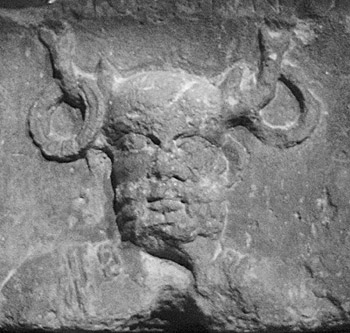Mirror: http://tinyurl.com/qdr3vcy
Farmana seal.(March 2009) alloy metal pewter workshop
![]() Santali glosses This shows the semantics: khaNDa 'implements'. Thus ayaskANDa hieroglyphs 'fish PLUS arrow' signify: metal implements.
Santali glosses This shows the semantics: khaNDa 'implements'. Thus ayaskANDa hieroglyphs 'fish PLUS arrow' signify: metal implements.
See: http://bharatkalyan97.blogspot.in/2015/09/indus-script-corpora-hieroglyphs-link.html Indus Script Corpora hieroglyphs link to 1) Pillar of Boatmen, 2) Cernunnos, smith-boatman on Gundestrup cauldron and 3) Kirkburn triskele hieroglyph![]() Cernunnos. Twigs as horns with rings. koD 'horn' koDiyum 'ring on neck' (Gujarati) Rebus: koD 'workshop' (Kuwi).कूदी [p= 300,1]f. a bunch of twigs , bunch (v.l. कूट्/ई) AV. v , 19 , 12 Kaus3.accord. to Kaus3. , Sch. = बदरी, "Christ's thorn". Rebus: kuThi 'smelter'
Cernunnos. Twigs as horns with rings. koD 'horn' koDiyum 'ring on neck' (Gujarati) Rebus: koD 'workshop' (Kuwi).कूदी [p= 300,1]f. a bunch of twigs , bunch (v.l. कूट्/ई) AV. v , 19 , 12 Kaus3.accord. to Kaus3. , Sch. = बदरी, "Christ's thorn". Rebus: kuThi 'smelter'
Metalwork catalogue depicted on the Farmana seal is unambiguous and complete. It is a celebration of the Tin-Bronze Age revolution brought about by metal castings and creation of alloys.
S. Kalyanaraman
Sarasvati Research Center
September 16, 2015
Farmana seal.(March 2009) alloy metal pewter workshop
rāngo ‘water buffalo bull’ (Ku.N.)(CDIAL 10559) Rebus: rango ‘pewter’. ranga, rang pewter is an alloy of tin, lead, and antimony (anjana) (Santali).
 Santali glosses This shows the semantics: khaNDa 'implements'. Thus ayaskANDa hieroglyphs 'fish PLUS arrow' signify: metal implements.
Santali glosses This shows the semantics: khaNDa 'implements'. Thus ayaskANDa hieroglyphs 'fish PLUS arrow' signify: metal implements. Cernunnos. Twigs as horns with rings. koD 'horn' koDiyum 'ring on neck' (Gujarati) Rebus: koD 'workshop' (Kuwi).कूदी [p= 300,1]f. a bunch of twigs , bunch (v.l. कूट्/ई) AV. v , 19 , 12 Kaus3.accord. to Kaus3. , Sch. = बदरी, "Christ's thorn". Rebus: kuThi 'smelter'
Cernunnos. Twigs as horns with rings. koD 'horn' koDiyum 'ring on neck' (Gujarati) Rebus: koD 'workshop' (Kuwi).कूदी [p= 300,1]f. a bunch of twigs , bunch (v.l. कूट्/ई) AV. v , 19 , 12 Kaus3.accord. to Kaus3. , Sch. = बदरी, "Christ's thorn". Rebus: kuThi 'smelter'Reading and translation: Excellent quantity cast and forge metal pewter workshop. dul ayaskANDa
rango koD sal (Glyphs: dul 'two'; ayo 'fish'; kANDa 'arrow'; sal 'bos gaurus';
rāngo ‘water buffalo bull’;
koD 'rings on neck').
Hierog
![]()
lyph: Rings on neck: koDiyum (G.) koṭiyum = a wooden circle put round the neck of an animal; koṭ = neck (Gujarati)
Rebus: koD 'artisan's
workshop'

(Kuwi) koD = place where artisans work (G.lex.) OP. koṭhārī f. ʻ crucible ʼ; Sv. dāntar -- kuṭha ʻ fire -- place ʼ; N. koṭho ʻ chamber ʼ, °ṭhi ʻ shop ; A. koṭhā, kõṭhā ʻ room ʼ, kuṭhī ʻ factory ʼ; Or. koṭhā ʻ brick -- built house ʼ, °ṭhī ʻ factory; WPah.kṭg. kóṭṭhi f. ʻ house, quarters, temple treasury, name of a partic. temple ʼ; kṓṣṭha n. ʻ pot ʼ Kauś., ʻ granary, storeroom' (CDIAL 3546) G. koṭhār m. ʻ granary, storehouse ʼ; WPah.kṭg. kəṭhāˊr, kc. kuṭhār m. ʻ granary, storeroom ʼ, J. kuṭhār, kṭhār m.; -- Md. kořāru ʻ storehouse ʼ; kōṣṭhāgāra n. ʻ storeroom, store ʼ Mn. (CDIAL 3550)
koṭe 'forge' (Mu.)
koṭe meṛed = forged iron, in contrast to dul meṛed, cast iron (Mundari.lex.)
Metalwork catalogue depicted on the Farmana seal is unambiguous and complete. It is a celebration of the Tin-Bronze Age revolution brought about by metal castings and creation of alloys.
S. Kalyanaraman
Sarasvati Research Center
September 16, 2015